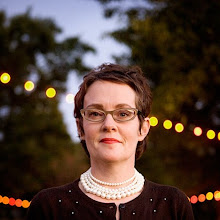
Llyn Foulkes, Central Pavilion. All photos courtesy the author.
Imagine my surprise to see a room of Llyn Foulkes works at the Giardini. This under-rated LA-based painter has made powerful, disconcerting works since the 1960s. His presence made me appreciate the diligence with which Bice Curiger curated the show (although not sure that the historical works in the first room of the pavilion made sense).

Erwin Wurm.
Erwin Wurm's skinny house, just beside the Accademia bridge, is based on his parent's home and mocks the over-consuming lifestyles in the West. This modest profile fits with Venice however, a city where even the most grandiose palazzo doesn't match the egregious waste of resources or space of a modern McMansion.

Yael Bartana, Polish pavilion.
The presence of an Israeli artist in the Polish pavilion is an example of inspired national cross-over. Bartana imagines a political movement in Poland that begs Israelis of Polish descent to return, re-populate the country and save Poland from a death of homogeneity. One would understand Israeli's not falling for it, but the language was blunt and overt, bemoaning the evil act of killing Jews or forcing them to flee during World War II. Very interesting timing for this work.

Christian Marclay, Arsenale.
I finally got to see at least part of Christian Marclay's work about time. I read all the NY reviews of the work and finally understood the operatic, deeply meditative pleasure of the work. We passed our time with the piece from 2:25 to 3:50 pm, resting on the (uncomfortable) couches yet mesmerized by the ease with which I created mini-historical narratives I made up while watching.

Segalit Landau, Israeli pavilion.
Finally, Segalit Landau's lovely installation looking at water politics in Israel was both sweet and stifling. Through different videos she narrated the struggle for cooperation between political enemies for the appropriate management of water. This video, of a little girl tying together the shoelaces of negotiating politicians, made the most pertinent point--everyone is tied together whether they like it or not, so harming one's enemy is harming oneself.
Simple but effective.




No comments:
Post a Comment